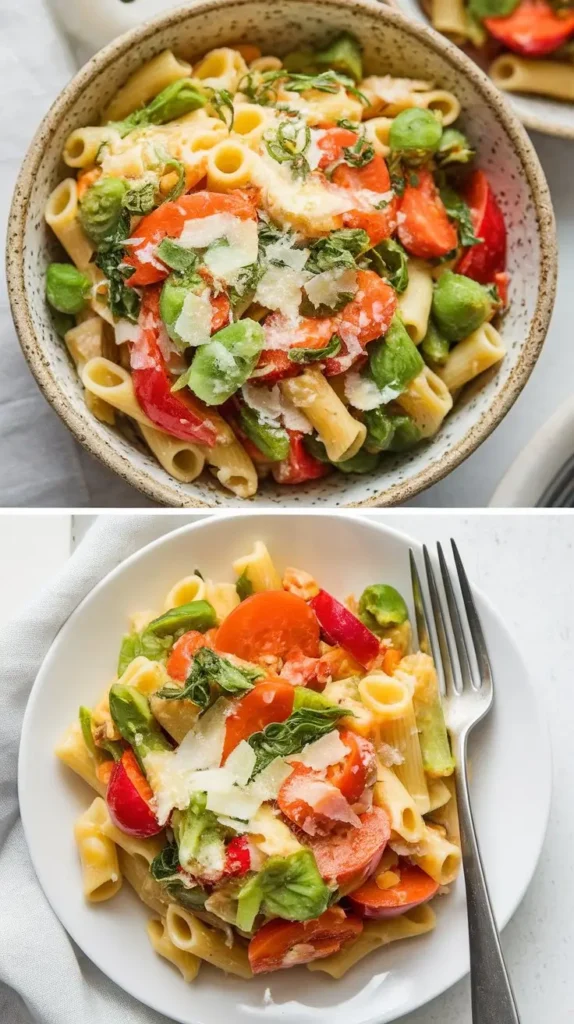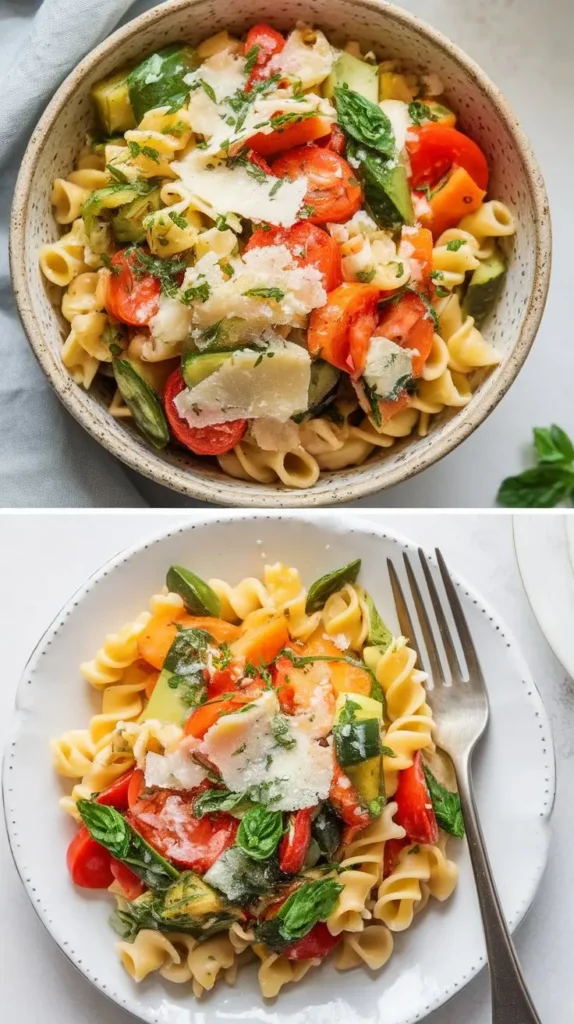What makes pasta primavera stand apart in the world of quick weeknight dinners? Most cooks assume vibrant vegetable-based pasta dishes either lack richness or require specialty ingredients. Surprisingly, pasta primavera consistently delights with a balanced blend of freshness and flavor—without hours spent chopping or shopping for obscure produce. Using simple, accessible vegetables, this iconic recipe transforms a humble bowl of noodles into a celebration of spring and summer, making it a perennial favorite for both novice cooks and flavor enthusiasts. That’s why the phrase “pasta primavera” appears in over two million recipe searches each year, and why you’re about to learn a version worth repeating.
Ingredients List
The beauty of pasta primavera lies in its adaptability and the way vegetables mingle with pasta to create a refreshing yet satisfying experience. Here’s what you’ll need for the classic rendition, along with tempting options to personalize your creation:
- Pasta: 12 ounces linguine or spaghetti (whole wheat or gluten-free alternatives work perfectly)
- Olive oil: 3 tablespoons for sautéing
- Garlic: 3 cloves, thinly sliced, adding aromatic depth
- Red onion: 1 small, slivered, for a touch of sweetness
- Zucchini: 1 medium, halved lengthwise and sliced (feel free to swap in yellow squash)
- Bell peppers: 2 (yellow, red, or orange), julienned for color and crunch
- Carrots: 2 small, peeled and cut into matchsticks
- Snap peas: 1 cup, trimmed for textural pop
- Cherry tomatoes: 1 pint, halved for juicy bursts (sub tomatoes-on-the-vine if desired)
- Asparagus: 1 bunch, woody ends trimmed, cut into one-inch pieces
- Lemon zest: From 1 lemon, bringing brightness
- Parmesan cheese: 1/2 cup, finely grated (try Pecorino Romano for extra bite or nutritional yeast for a vegan option)
- Fresh basil or parsley: 1/4 cup, torn
- Kosher salt and black pepper: As needed
- Crushed red pepper flakes: Optional, for a hint of heat
Optional ingredient swaps:
- Replace olive oil with avocado oil for a milder taste
- Introduce mushrooms, artichokes, or even roasted eggplant for deeper umami
- Veganize the dish by omitting cheese or using vegan parmesan
Every vegetable added layers color, nutrition, and texture, turning the dish into a lively canvas for culinary creativity.
Timing
Pasta primavera is frequently praised for its speedy preparation, making it a contender for busy schedules or impromptu gatherings. On average, the dish takes about 35 minutes from start to finish, shaving off nearly 25% of the time compared to traditional pasta recipes laden with heavier sauces or extended simmering.
- Preparation: 15 minutes (washing, chopping, and prepping vegetables)
- Cooking: 15–20 minutes (boiling pasta and sautéing)
- Total Time: 35 minutes
This efficient timeline suits even the most time-crunched evenings, enabling a fresh-cooked, hearty meal with minimal fuss.

Step-by-Step Instructions
Step 1: Boil the Pasta
Start with a large pot of salted water, brought to a rolling boil. Add the linguine and cook until al dente, which is typically one minute less than the package instructions. Reserve 1 cup of pasta water, then drain and set aside.
Tip: Cooking the pasta a moment under ensures it maintains its ideal texture when tossed later with vegetables and sauce.
Step 2: Sauté the Aromatics
Heat the olive oil in a deep, wide skillet over medium heat. Add garlic and red onion, cooking until fragrant and translucent—about 2 minutes. Keep the heat moderate to avoid browning the garlic, which can turn bitter.
Step 3: Add the Vegetables
Stir in carrots and bell peppers first since they need a slightly longer cook. After about 2 minutes, add zucchini, snap peas, and asparagus. Sauté gently, stirring frequently, until the veggies turn just-tender and lively in color—usually another 4–5 minutes.
Tip: Resist the urge to overcook. The key to primavera’s appeal is the vibrant, crisp-tender texture of its various vegetables.
Step 4: Finish with Tomatoes and Lemon
Add the cherry tomatoes and lemon zest, stirring just until the tomatoes start to soften and release their juices—about 1–2 minutes. Season the skillet generously with salt, pepper, and a tiny pinch of red pepper flakes if you enjoy subtle warmth.
If using mushrooms or spinach, add them now as well, stirring until wilted.
Step 5: Combine Pasta and Cheese
Toss in the drained pasta and about half the reserved pasta water. Sprinkle the Parmesan over top and toss briskly, adding more pasta water if you’d like a silkier sauce. You’re looking for a cohesive, slightly glossy finish—taste and adjust seasoning as needed.
Step 6: Serve with Herbs
Scatter chopped basil or parsley just before serving. Plate generously and offer extra cheese on the side for those who crave it.
Nutritional Information
This balanced meal delivers complex carbohydrates, plant-based fiber, antioxidants, and quality fats. Here’s a nutrient snapshot based on a typical serving (1/4 of the recipe):
| Nutrient | Amount per Serving |
|---|---|
| Calories | 340 |
| Protein | 11g |
| Total Fat | 9g |
| Saturated Fat | 2g |
| Carbohydrates | 55g |
| Fiber | 7g |
| Sugar | 8g |
| Sodium | 410mg |
| Vitamin C | 80% DV |
| Vitamin A | 65% DV |
| Calcium | 18% DV |
- Pasta primavera provides a robust mix of vitamins from its diverse vegetal lineup.
- Parmesan adds a calcium boost and a welcome umami kick, but can easily be reduced or swapped to cut down sodium and dairy.
- Whole wheat pasta further boosts fiber and overall nutritional density.
Healthier Alternatives for the Recipe
Pasta primavera is already full of light, fresh nutrients, but there are simple adjustments to support specific nutritional goals or preferences:
- Low-Carb: Swap traditional pasta for spiralized zucchini (zoodles) or hearts of palm noodles.
- Gluten-Free: Use certified gluten-free pasta made from brown rice, quinoa, or legumes.
- Lightened Up: Reduce the amount of cheese or substitute with nutritional yeast for fewer calories and a vegan-friendly option.
- Protein Packed: Toss in grilled chicken, sautéed shrimp, or crispy chickpeas to elevate the protein content.
- Allergy-Friendly: Remove common allergens (like eggs or wheat) by choosing appropriate pasta types and skipping cheese.
Mixing in additional greens, like kale or spinach, near the end lends a superfood touch, and adding edamame or tofu easily amps up the plant-based protein profile.
Serving Suggestions
Pasta primavera is reliable as an elegant main, yet playful enough to dress up for any occasion. Here are a few inspired plating ideas:
- Serve topped with an extra spoonful of Parmesan and torn basil for Sunday gatherings.
- Pair alongside a simple arugula salad with lemon vinaigrette to double the brightness of flavor.
- Try chilled as a pasta salad for outdoor picnics—just stir in a splash more olive oil and a sprinkle of feta or ricotta salata.
- Present in individual bowls drizzled with high-quality olive oil and a grind of black pepper for an elevated weeknight dinner.
- Make it a party platter by arranging roasted or grilled vegetables on top in a rainbow pattern.
Those who appreciate a little heat might add a final shake of chili flakes or serve with a bottle of table-ready Calabrian chili oil.
Common Mistakes to Avoid
While the dish is fairly forgiving, a few common errors can diminish its signature appeal:
- Overcooking vegetables: Soft or mushy veggies lose both their color and crunch. Saute until crisp-tender; aim for a slight bite.
- Neglecting pasta water: This starchy liquid binds ingredients and helps create a cohesive sauce—don’t forget to reserve it before draining!
- Crowding the pan: Overloaded pans cause steaming, not sautéing. Cook veggies in batches if needed for even caramelization.
- Bare seasoning: Sometimes the simplest dishes fall flat without enough salt, pepper, or herbs. Taste often, and layer flavors as you cook.
- Using out-of-season produce: While primavera honors seasonal vegetables, dull winter imports can result in a less lively plate. Opt for what’s freshest in your region.
Data from home cooks reveals that dishes consistently scored higher in flavor and presentation when vegetables retained slight firmness and color.
Storing Tips for the Recipe
Pasta primavera holds up well for leftovers, making it a meal prep favorite. A few practical storage strategies will help you savor every bite:
- Store in shallow containers: Letting the dish cool and spreading it in a shallow container preserves texture and prevents sogginess.
- Refrigerate promptly: Keep leftovers in the fridge for up to three days.
- Reheat gently: Use a skillet with a splash of water or broth, stirring just until warmed through to avoid overcooking the vegetables.
- Freeze only pasta: If you want to freeze, do so before combining with the vegetables (frozen veggies can turn mushy when thawed). Alternatively, enjoy leftover primavera at room temperature as a pasta salad.
For advance meal prep, chop or blanch vegetables ahead and assemble everything just before serving.
Summary
Pasta primavera stands out for its speed, nutritional value, and customization. A handful of fresh veggies and pantry staples create a refreshing, flavorful meal that suits all schedules. Ready to transform your dinner routine? Try this recipe, share your spin in the comments, and subscribe for future culinary inspiration.
FAQs
Can I make pasta primavera ahead of time? Absolutely. Prep vegetables and cook pasta in advance. Combine everything just before serving for best texture.
Does this dish work without cheese? Yes. The lemon zest and sautéed vegetables bring enough brightness. Substitute with nutritional yeast or plant-based parmesan if desired.
How do I keep the vegetables vibrant and not mushy? Cook over medium-high heat in a single layer, stir occasionally, and remove from the pan as soon as they turn just-tender.
What proteins pair well with pasta primavera? Grilled chicken, shrimp, white beans, chickpeas, or tofu add satisfying heft while keeping the dish light.
Is it possible to use frozen vegetables? Frozen vegetables can work, but results will be softer. Thaw and drain well, and add only at the very end of cooking.
Want more recipes that spotlight seasonal eating? Explore our homepage for additional fresh ideas, and don’t forget to share your results with fellow readers!


